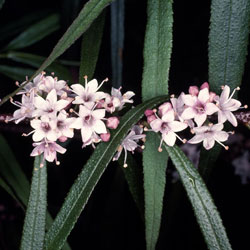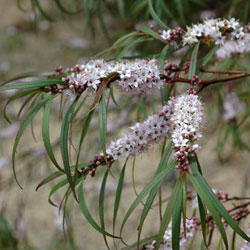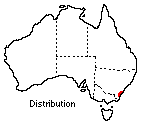Myoporum bateae
 |
 |
Myoporum bateae, a member of the Scrophulariaceae family, was described and named a century ago by Baron Ferdinand von Mueller, but within a few years he had reduced it to a synonym of M. floribundum. Such relegation to obscurity was a fate unworthy of this elegant plant. Only quite recently has it been recognised again as a species in its own right.
 A
restricted natural occurrence has contributed to the obscurity of M. bateae.
Its distribution extends sporadically down the New South Wales coast from the
Nepean River to Mt Dromedary, but nowhere is it common. The habitat of M.
bateae is tall Eucalyptus forest in steep mountain gullies where it favours
clayey, often rocky soils on moist, southerly or easterly aspects.
A
restricted natural occurrence has contributed to the obscurity of M. bateae.
Its distribution extends sporadically down the New South Wales coast from the
Nepean River to Mt Dromedary, but nowhere is it common. The habitat of M.
bateae is tall Eucalyptus forest in steep mountain gullies where it favours
clayey, often rocky soils on moist, southerly or easterly aspects.
The plants are pyramidal shrubs 3-5 m tall, with either one or a few slim, straight stems bearing slender, horizontal branches. The fresh, green foliage is rather sparse with the leaves elegantly curved downwards from the branchlets. Individual leaves are narrowly lanceolate, tapering to a long acute apex and are 4-8 cm long and 2-6 mm broad. They are thin and soft with finely toothed margins and are dotted with raised glands.
From September to November, clusters of pale mauve flowers appear along the branchlets, so numerous that the plant seems to have been dusted with pink snow. The miniature flowers are about 5 mm broad. They are followed by thin, flat, dry fruits about 2 mm long.
Propagation can be achieved from cuttings, which strike readily within two months. The potential for establishment of M. bateae from seed has not been explored. However, other species of Myoporum have given poor results. So far, no pests have been observed on M. bateae.
For best results, plants should be sited in a cool, moist, partially shaded position. A rich loam or clay soil should be suitable provided that it is free from lime. Myoporum bateae is moderately frost tolerant but temperatures below -5ºC will cut it back severely. With age, the shrubs can become open and straggling and may need pruning to thicken the foliage.
Several individuals of M. bateae were planted along the northern edge of the Rainforest Gully at the Gardens. There they thrived, achieving heights of 3-5 m within six years. It is evident that they enjoy the heavy clay soils and abundant moisture in this situation. Those plants growing in the dappled shade of eucalypts have the ideal pyramidal form of the species. Plants in heavy shade are etiolated, while others in nearly full sun are straggling.
Myoporum floribundum is closely related to M. bateae. Despite this close relationship, M. floribundum is readily distinguished by its pure white flowers and by its threadlike leaves which have no teeth and which hang quite vertically from the branchlets. Its habit is very different, tending to spread horizontally. It is time that Myoporum bateae was brought out of obscurity and made a worthy addition to native gardens.
Text by Michael Crisp, ANBG (1986)
Name meaning: Myoporum bateaeMyoporum - from the Greek, myo, to close or be shut, and poros, pore, referring to its ability to exist in dry areas; bateae - named in honour of the collector of the type specimen, Miss Mary Bate. |
![An Australian Government Initiative [logo]](/images/austgovt_brown_90px.gif)

